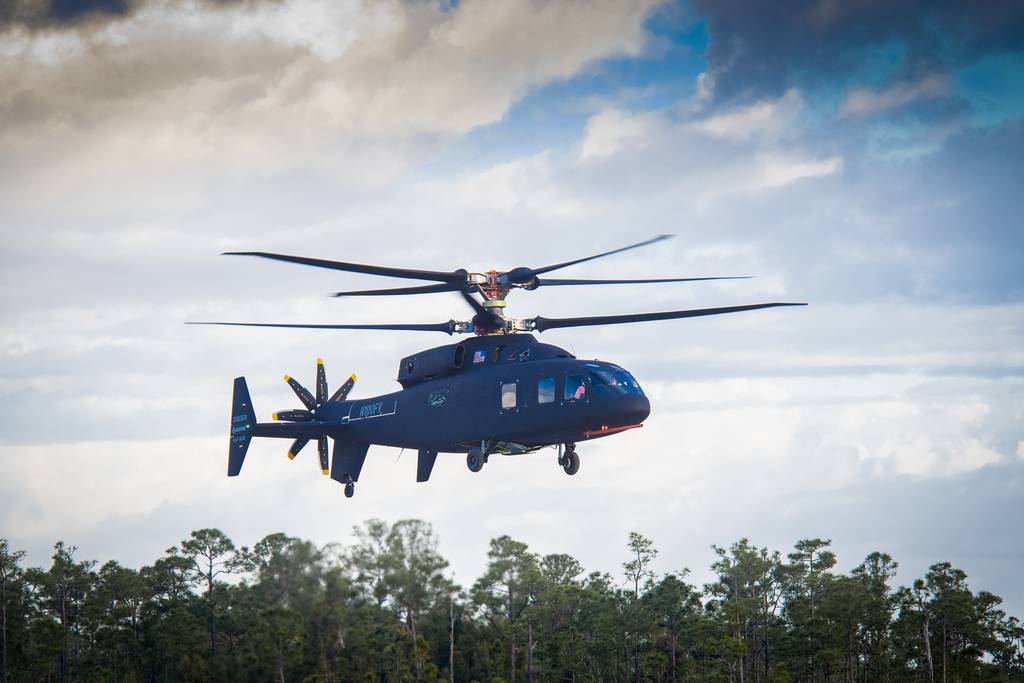WASHINGTON — The Army is taking its final steps before starting a competition to acquire a Future Long Range Assault Aircraft, and has done so by issuing an intent to solicit bids using means “other than full and open competition,” according to a Dec. 9 post on on the government contracts website Beta.Sam.Gov.
This step means that unless a surprise vendor can meet all of the Army’s technical and production requirements for FLRAA in the next two weeks, the future aircraft will be supplied by either Bell or Lockheed Martin’s Sikorsky.
Bell and a Sikorsky-Boeing team have been pitted against one another for years to build and fly technology demonstrators to inform requirements ahead of the FLRAA competition and both are part of a competitive demonstration and risk reduction phase. Bell’s V-280 Valor tiltrotor had it’s first flight nearly three years ago and Sikorsky and Boeing’s SB-1 Defiant coaxial helicopter flew for the first time in March 2019.
The draft request for proposals is expected to be released by the end of the year with a final solicitations expected in fiscal 2021.
Modernizing its vertical lift fleet is the Army’s third highest priority behind Long-Range Precision Fires and Next-Generation Combat Vehicle development. The Army intends to field both a FLRAA and Future Attack Reconnaissance Aircraft by roughly FY30.
Bell and Lockheed Martin are also competing against each other in the FARA competition. Bell’s offering is the 360 Invictus and Lockheed’s entry is the Raider X.
In the case of FLRAA, the winner must build eight production aircraft for the first unit equipped by FY30.
The plan is to award a contract to a winner in FY22. The winner will proceed to deliver a preliminary design review roughly eight months following the award.

According to the pre-solicitation, “the Army has determined through extensive market research, including a July 2020 sources sought, that only two sources exist in the market space that have the capability and capacity of developing, manufacturing, testing and delivering both prototype and initial production FLRAA in the time allocated to achieve the Army’s goal of an FUE in FY 2030.”
The Army stated that Bell and Sikorsky are those two sources, but notes that “any other responsible, qualified sources, … that can develop and produce the FLRAA weapon system to achieve First Unit Equipped (FUE) no later than 2030 are encouraged to full identify their interest and capabilities in accordance with the requirements,” within 15 days after publication of the pre-solicitation.
Such a vendor would need to deliver a preliminary design review in FY22, start building prototype aircraft in the third quarter of FY23 and eight production aircraft by 2030. Vendors must also prove they are able to build 24 aircraft per year at full-rate production.
Those aircraft must be able to fly at 2,000 feet pressure altitude in 85 degree heat with a full payload that consists of 12 troops at 290 lbs each and four crew at 281 lbs each.
When the draft RFP drops, it is likely to contain a schedule to deliver air vehicle prototypes and mission systems. The Army was debating between two schedule options to deliver prototypes by roughly mid-2026.
The FLRAA program has strong support from Congress. This year’s annual defense policy bill authorized $5 million in increased investment in FLRAA advanced component development and prototyping on top of the Army’s nearly $648 million request. The FY21 spending bill has yet to go through conference committee, but both the House and Senate proposed additional funding for FLRAA. The House Appropriations Committee proposed a $20 million increase while the Senate Appropriations Defense Subcommittee proposed a $79 million addition.
Lawmakers added $76 million in funding to FLRAA’s top line in FY20 to drive down technical risk and speed up delivery through the competitive demonstration and risk reduction effort.
In FY20, Congress cut $34 million from the Army’s other future vertical lift effort — the FARA program — which threatened the service’s ability to provide some of its government-furnished equipment to competitors chosen to build and fly prototypes. The Army is supplying its new Improved Turbine Engine Program engine, a 20mm gun, an integrated munitions launcher and its modular open-systems architecture. The Army has since shored up that funding, according to service aviation leadership.
Jen Judson is an award-winning journalist covering land warfare for Defense News. She has also worked for Politico and Inside Defense. She holds a Master of Science degree in journalism from Boston University and a Bachelor of Arts degree from Kenyon College.








